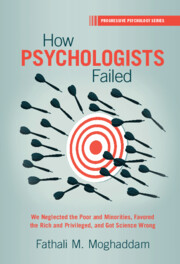 How Psychologists Failed
How Psychologists Failed Book contents
- HOW PSYCHOLOGISTS FAILED
- The Progressive Psychology Book Series
- How Psychologists Failed
- Copyright page
- Dedication
- Contents
- Preface
- Acknowledgments
- Chapter 1 Why We Must Rethink Psychology
- Part I Psychological Processes
- Part II Rethinking Behavior in the Larger World
- Chapter 8 Mental Health and ‘Be Happy’ Psychology
- Chapter 9 Looking through the Wrong Side of Prison Bars: The Psychology of Injustice
- Chapter 10 Psychology for the Masses in Non-Western Societies
- Part III Looking Ahead
- Notes
- References
- Index
Chapter 9 - Looking through the Wrong Side of Prison Bars: The Psychology of Injustice
from Part II - Rethinking Behavior in the Larger World
Published online by Cambridge University Press: 27 October 2022
- HOW PSYCHOLOGISTS FAILED
- The Progressive Psychology Book Series
- How Psychologists Failed
- Copyright page
- Dedication
- Contents
- Preface
- Acknowledgments
- Chapter 1 Why We Must Rethink Psychology
- Part I Psychological Processes
- Part II Rethinking Behavior in the Larger World
- Chapter 8 Mental Health and ‘Be Happy’ Psychology
- Chapter 9 Looking through the Wrong Side of Prison Bars: The Psychology of Injustice
- Chapter 10 Psychology for the Masses in Non-Western Societies
- Part III Looking Ahead
- Notes
- References
- Index
Summary
Prisons reflect a justice system for the rich, and an injustice system for the poor. Most people in prison are poor. Given the high recidivism rates, the purpose of prisons is not to teach convicted criminals that crime does not pay. A close examination of what happens to people in prison shows that there is very little effort to reform and offer education, and much more effort to isolate and punish. There is serious collatoral damage, with the deepest harm inflicted on the family of the incarcerated. In the United States, the children of incarcerated, paroled, and recently released parents number well over three million. Having a parent incarcerated negatively impacts these children, particuarly in terms of their mental health and educational performance. Ethnic groups are disproportionally represented in prison, but poverty is the most common feature of all the people from different ethnic groups in prison. The poor are the victims of the ongoing prison boom in the United States and in much of the rest of the world.
Keywords
- Type
- Chapter
- Information
- How Psychologists FailedWe Neglected the Poor and Minorities, Favored the Rich and Privileged, and Got Science Wrong, pp. 119 - 128Publisher: Cambridge University PressPrint publication year: 2022


